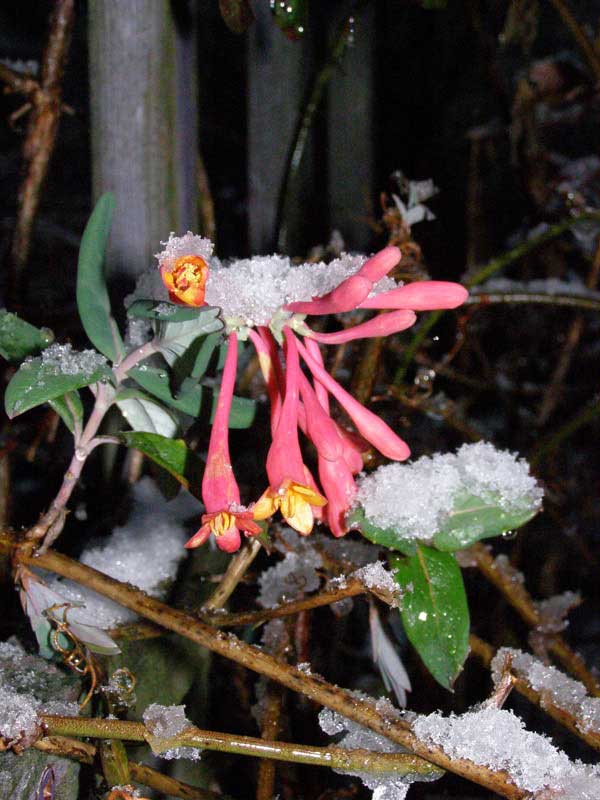“Dead of winter†summer reflections

Coral Honeysuckle flowering in mid-winter. Photo by Ken Moore
By Ken Moore
Flora Columnist
It’s the dead of winter, and two summer-flowering vines have captured my interest. A Coral Honeysuckle, Lonicera sempervirens, caught my eye two weeks ago when it screamed across my deck for attention from beneath its cap of snow! Several clusters of scarlet tubular flowers continue to flower in spite of the subsequent below-freezing temperatures. It’s the nature of this native vine to flower off and on throughout the summer into mid-December. Flowering now in midwinter is unusual. But, hey, that’s nature!
Normally, you may glimpse a few red flower clusters reaching out from the forest edge or roadside in late spring and early summer. More noticeable, however, are the masses of flowers where gardeners have established a Coral Honeysuckle on a mailbox, fencepost or other trellis structure in full sunlight. If you pause attentively for just a few minutes, you will likely be rewarded with a sighting of a hummingbird that can’t resist the nectar-filled flowers. Most nurseries now carry one or more cultivars of the Coral Honeysuckle, selected for vigorous re-blooming throughout the season. For me, the pure species puts on just as much of a show.
Coral Honeysuckle is common throughout our forests and roadsides. Unfortunately, we seldom notice this common vine because it does not thrive in forest shade or on sunny sites in competition with numerous exotic invasives, most particularly the Japanese Honeysuckle, Lonicera japonica. The Japanese Honeysuckle is loved by many because of its nectar-rich white flowers that scent up fields and woodland edges on warm early-summer evenings. However, this is not reason enough to allow such an invasive pest to continue covering our wild and cultivated landscapes.
My second winter-interest native vine is the Trumpet-creeper, Campsis radicans. Its orange tubular flowers (also irresistible to hummingbirds) are commonly seen hanging from vines on fence posts, trees and abandoned chimneys everywhere in the midsummer. In the winter months, the curious 4-to-7-inch-long brownish, dry, bean pod-like fruit at the ends of outstretched stems are a real curiosity to many folks who do not connect them with those summer flower clusters. I enjoy watching those hanging seed pods dancing around in the winter winds.
A special curiosity for me this winter was noticing several goldfinches hanging onto the Trumpet-creeper pods near my birdfeeders. Several days of repeated observations proved to me that those birds were diligently extracting the thin wafer-like seeds from within the pods that were slightly splitting along the sides. I tried in vain to get close enough to photograph that discovery, but those smart birds were not about to let me capture their secret. I’m accustomed to goldfinches going for the thistle and sunflower seed, but I never imagined the Trumpet-creeper as a food source for them.
These two vines are worth seeking out in local garden centers for a late-winter planting in your home landscape. Not only are you providing nectar for hummingbirds during the warm season, you are providing seed for goldfinches and winter interest for yourself during the cold months.
Email Ken Moore at flora@carrborocitizen.com. Find previous Ken Moore Citizen columns at The Annotated Flora (carrborocitizen.com/flora).



Comments are closed.